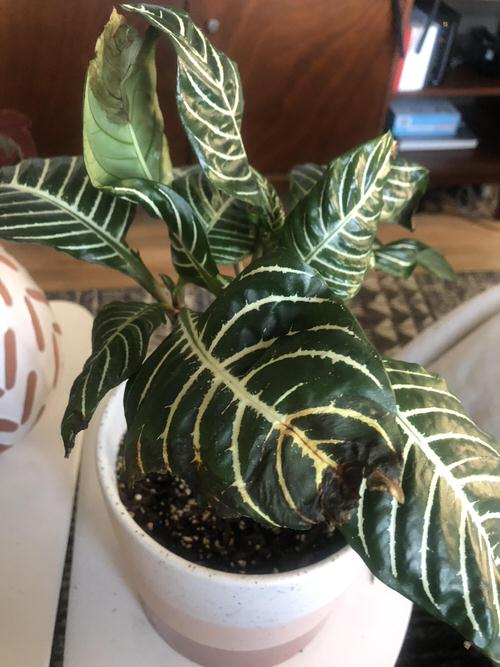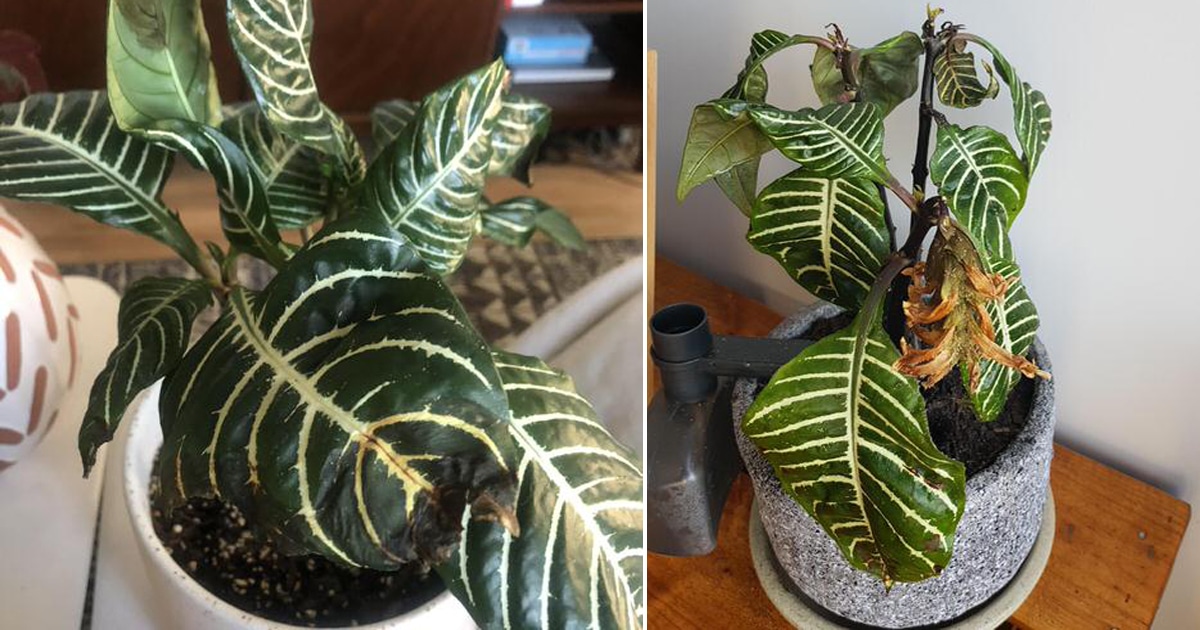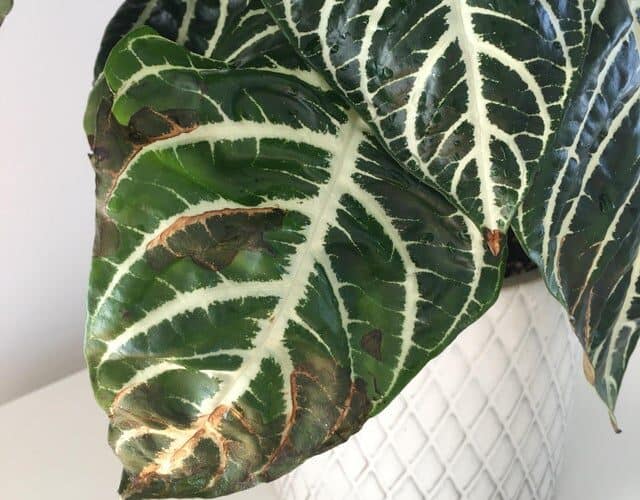Zebra succulents experience drought stress as a result of little or excessive watering, which causes the brown tips on their leaves. Zebra leaf tips turning brown as an indication of stress is also caused by hot temperatures, strong air currents, and intense sunshine.
Being smaller and more compact than most succulent species, zebra succulents (also known as zebra Haworthia, zebra cactus, and Haworthiopsis fasciata) may be more vulnerable to drought stress if planted in adverse conditions.
If the zebra plant’s lower leaves are also becoming brown and crispy, it means the soil is drying up too quickly for a variety of reasons or the plant is not receiving enough water.
For a variety of causes, zebra succulent leaf tips may experience drought stress:
- watering insufficiently.
- not watering enough frequently.
- Convection currents and wind currents indoors or air conditioning currents outdoors.
- The soil dries out too soon since the zebra succulent is close to a heat source.
- Due to the drought, potting soil has dried out and become hard, making it more difficult for water to get to the roots.
- too much heat.
- exposure to the sun’s rays.
Read on to find out why the tips of your zebra plant’s leaves are becoming brown and how to fix it.
Table of Contents
Brown Tips due to Under Watering
Native to Southern Africa, zebra succulents thrive in hot settings with little rainfall and arid soils that do not hold much moisture in the roots.
However, when it does rain in their natural location, it usually comes as a strong downpour that greatly soaks the soil, allowing the roots to absorb the water they need and store it in their large leaves in order to withstand drought.
If you want to stop your zebra succulents from growing brown tips, mimic their natural environment by thoroughly wetting the soil and letting any extra water drip out of the drainage holes on the bottom of the pot.
So that the roots can absorb the necessary moisture, this ensures that the water has permeated the potting soil.
Only the top inch or two of the soil remains moist when you water too lightly, and the water does not get to the roots, causing the leaf tips to become brown.
Zebra plants should be watered after the potting soil has dried since this simulates the cycle of a deep soak in the soil followed by a dry spell.
If grown indoors in a pot, this often involves watering your zebra plant once every two weeks, though this can vary according on the local environment and conditions.
This guarantees the ideal moisture balance, meeting the zebra succulents’ water needs while preventing overwatering’s negative consequences, like root rot.
A regular watering schedule and thorough soak in water can make the plant seem healthy again by preventing the browning of the leaf tips.
To establish the ideal watering cycle for zebra succulents in your climate and conditions, read my post on how to water zebra succulents.
Air Currents Can Cause Leaf tips to Turn Brown
As a result, if you are growing them outside in open spaces with strong winds or indoors with air conditioning, draughts, or forced air, they may not necessarily grow properly.
The zebra succulent thrives in low-humidity surroundings, so it rarely has to deal with the drying effects of air conditioning, which quickly dries up the moisture in the pot and steals it from the leaves, causing the leaf tips to turn brown as a symptom of stress.
Zebra succulents may tolerate windy situations, but you should always place them away from strong air currents and heat sources in a spot in your house or yard that receives bright indirect light so the plant can recuperate.
(For additional information, see my article on how to save a dying zebra plant.)
Zebra Succulent Potting Soil Repels Water Causing Drought Stress
Zebra plants need the soil to dry out between waterings in order to mimic the natural cycle of watering and soil moisture in their natural habitat.
However, if the zebra succulent is planted in typical potting soil, it may bake hard in between waterings, especially if the soil also contains peat moss, which can keep moisture from evaporating from the soil’s surface as it dries up.
This may result in all the water running off the soil’s top, down the edge of the pot, and out the drainage holes in the base without adequately soaking into the soil.
As a result, your zebra plant’s roots are unable to get the moisture they need, and as an indication of drought stress, the leaf tips of your zebra plant start to become brown and crispy.
Zebra succulents should be replanted in specially formulated succulent and cacti soil that closely resembles the soil conditions in the zebra succulents’ native environments if your soil is water-repellent.
The unique succulent and cactus soil has the soil profile that succulents need as well as a porous, well-draining texture that allows water to properly permeate even after it has dried up entirely.
This enables your zebra succulent to absorb the water it needs to keep the tips of its leaves from becoming brown. In the coming weeks, your plant’s look ought to start to improve.
(Read my post on how to cultivate and take care of zebra succulents for a complete list of best practices.)
Excess Heat
Instead of full sunlight, zebra succulents prefer bright, indirect light. Therefore, they would rather deal with the stress of intense light and high temperatures than enjoy the cooler temperature afforded by some shade.
55°F to 80°F (13°C to 27°C) is the ideal temperature range for zebra succulent growth. Despite their temporary tolerance of higher temperatures, this can speed up soil drying and prevent roots from absorbing the necessary moisture.
Higher temperatures also cause the leaves to lose moisture, which causes the leaf tips to become brown and crispy.
If at all feasible, keep the zebra succulent between 55°F and 80°F (13°C and 27°C) to prevent stress on the plant.
Direct Sunlight
The succulent may turn red or even white as a sign of stress when exposed to harsh sun, which can also dry out the leaf tips.
If you find that your zebra succulent is turning red or white, it is most likely suffering from too much sunshine. A healthy zebra succulent has dark green leaves with a white stripe.
The plant should recover once it is out of direct sunlight as long as the zebra succulent is not sunburnt (which might leave brown dry spots).
Key Takeaways:
- When zebra succulents experience drought stress from insufficient or excessive watering, the tips of their leaves turn brown.
- As an indication of stress, high temperatures, excessive wind, air conditioning, and too much sun can also cause the leaf tips to become brown.
- To prevent brown leaf tips, zebra succulents prefer strong indirect light and temperatures between 55°F and 80°F (13°C and 27°C).
- Always give zebra succulents a good soak and place them away from strong air currents.
FAQ
How often do you water zebra succulents?
Once every two weeks in the winter and once a week or so in the summer. Feeding When it is growing, try fertilizing once every three months.
What is wrong with my zebra plant?
Crispy leaves can be a sign of low humidity, temperature changes, too much light, or prolonged dryness on your zebra plant’s otherwise boldly striped leaves. You should keep your Zebra plant in a humid atmosphere. Incorporate a pebble tray, mist frequently, or put a humidifier close by.
How do I fix brown leaves on my zebra plant?
Simply moving your zebra plant out of direct sunlight will solve this issue. Your plant’s leaves will begin to regrow after you do that. It is always advised that you relocate your plant to northern windows because southern windows receive the brightest exposure to sunshine.
Why is my zebra succulent leaves turning brown?
When zebra succulents experience drought stress from insufficient or excessive watering, the tips of their leaves turn brown. As an indication of stress, high temperatures, excessive wind, air conditioning, and too much sun can also cause the leaf tips to become brown.
What do you do when zebra leaves turn brown?
The edges of the plant’s leaves may become brown due to a lack of humidity. Keep the plant on a pebble tray with water in it to increase humidity to avoid this from happening. A humidifier is another option for this.



